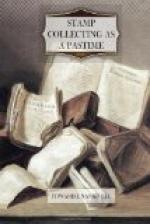Collectors are divided into two classes—the general collector and the specialist. The general collector takes everything that comes in his way, and knows no limitations, no exclusions of this country or that. The specialist, on the other hand, confines his attention to the stamps of one or more particular groups or divisions, or even to one particular country.
The most experienced collectors, whether general or specialist, almost invariably advise the beginner to start as a general collector. As a beginner he will have no experience to guide him in the choice of a particular group or division; and until he has travelled over the ground as a general collector it will be difficult for him to make a choice which he may not have cause to regret. As a general collector he will gather together a general knowledge of stamps in all their peculiar varieties, which can scarcely fail to be immensely useful to him even should he subsequently drift into specialism. Indeed, it is an accepted truism that the man who starts as a general collector invariably makes the best specialist in the end.
Starting, then, as a general collector, the beginner purchases an album—for choice say the “Imperial,” published by Stanley Gibbons, Ltd., which on one page has a printed and illustrated list of the stamps of a country, and on the opposite page ruled and numbered spaces for every stamp mentioned in the printed list. A catalogue, setting forth the prices at which stamps may be purchased, should also be obtained.
One of the very first questions to be settled at the start will be the choice that must be made between the collection of used and of unused. The general collector who wishes to collect economically should certainly start with what is cheapest; and as the common stamps are cheapest in the used condition, used should be selected. When a collector can afford to spend his money liberally, the best and safest, and cheapest in the long run, will be stamps unused and in the pink of condition. Such stamps generally turn out to be a safe and not unfrequently a splendid investment.
The beginner will find that he can fill up a large proportion of the spaces in his album with comparatively common stamps, and these are much more economically purchased in the form of cheap packets. The blanks that remain will then represent stamps worth searching for separately, and buying singly as good opportunities occur. Many may be obtained in exchanging duplicates with other collectors.
After some experience as a general collector, preferences will gradually materialise, and the utter hopelessness of making a thorough collection of the postal issues of the world will be apparent. At this stage the collector generally sells the bulk of his collection, reserving only a few countries to be followed up in future on specialist lines. The remedy and the change are drastic, and, like most drastic remedies, are much too sweeping. Wiser and keener Philatelists




